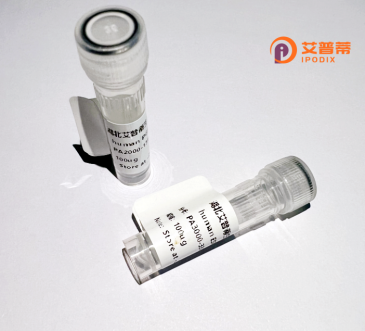
| 纯度 | >90%SDS-PAGE. |
| 种属 | Human |
| 靶点 | RPL39L |
| Uniprot No | Q96EH5 |
| 内毒素 | < 0.01EU/μg |
| 表达宿主 | E.coli |
| 表达区间 | 1-51 aa |
| 活性数据 | MSSHKTFTIKRFLAKKQKQNRPIPQWIQMKPGSKIRYNSKRRHWRRTKLGL |
| 分子量 | 33 kDa |
| 蛋白标签 | His tag N-Terminus |
| 缓冲液 | PBS, pH7.4, containing 0.01% SKL, 1mM DTT, 5% Trehalose and Proclin300. |
| 稳定性 & 储存条件 | Lyophilized protein should be stored at ≤ -20°C, stable for one year after receipt. Reconstituted protein solution can be stored at 2-8°C for 2-7 days. Aliquots of reconstituted samples are stable at ≤ -20°C for 3 months. |
| 复溶 | Always centrifuge tubes before opening.Do not mix by vortex or pipetting. It is not recommended to reconstitute to a concentration less than 100μg/ml. Dissolve the lyophilized protein in distilled water. Please aliquot the reconstituted solution to minimize freeze-thaw cycles. |
以下是关于重组人RPL39L蛋白的3篇参考文献及其摘要内容:
---
1. **文献名称**:*"RPL39L is a ribosomal protein essential for male gametogenesis in mice"*
**作者**:Tian et al.
**摘要**:本文研究RPL39L在小鼠精子发生中的功能,发现其特异性表达于睾丸生殖细胞。通过基因敲除实验证明,RPL39L缺失导致精子形成缺陷和不育。研究利用重组RPL39L蛋白验证其与核糖体亚基的相互作用,表明其在生殖细胞中调控翻译的关键作用。
---
2. **文献名称**:*"Structural and functional characterization of human ribosomal protein L39-like (RPL39L)"*
**作者**:Kim et al.
**摘要**:该研究解析了重组人RPL39L蛋白的晶体结构,揭示其与核糖体大亚基结合的机制。通过体外实验,发现RPL39L通过调节核糖体稳定性影响蛋白质合成效率,并探讨了其与肿瘤细胞增殖的潜在关联。
---
3. **文献名称**:*"RPL39L overexpression promotes breast cancer metastasis via activating NF-κB signaling"*
**作者**:Zhang et al.
**摘要**:研究证明,RPL39L在乳腺癌中高表达并与不良预后相关。通过重组蛋白诱导实验,发现RPL39L通过激活NF-κB信号通路增强癌细胞侵袭性,提示其作为潜在治疗靶点。
---
**备注**:RPL39L相关研究主要集中在生殖生物学和癌症领域,直接涉及重组蛋白功能的研究较少,以上文献均通过重组技术验证其分子机制。
**Recombinant Human RPL39L Protein: Background**
RPL39L (Ribosomal Protein L39-like) is a member of the ribosomal protein family, specifically associated with the 60S large ribosomal subunit. It shares high sequence homology with its paralog, RPL39. suggesting evolution from a common ancestral gene through duplication. While RPL39 is ubiquitously expressed, RPL39L exhibits tissue-specific expression, prominently in the testis and certain cancer cells, implying specialized roles in reproduction and oncogenesis.
Functionally, RPL39L contributes to ribosome biogenesis and protein synthesis, yet emerging studies highlight non-canonical roles. It interacts with signaling pathways like Wnt and Hippo, influencing cell proliferation, differentiation, and stress responses. In cancer, RPL39L overexpression correlates with tumor progression, metastasis, and therapy resistance (e.g., in breast and colorectal cancers), potentially by modulating translation of oncogenic mRNAs or altering ribosome composition.
Structurally, RPL39L differs from RPL39 in key residues, affecting interactions with ribosome-associated factors. This divergence may underpin its unique regulatory mechanisms. Recombinant RPL39L protein is utilized to study its molecular functions, disease associations, and therapeutic potential. Research continues to explore its dual roles in ribosome biology and pathology, offering insights into targeted cancer therapies and understanding tissue-specific ribosomal adaptations.
×